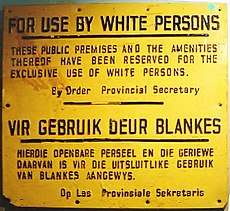Auto-segregation
Auto-segregation or self-segregation is the separation of a religious or ethnic group from the rest of society in a state by the group itself. This could also mean inability for a normal social interaction and a form of social exclusion.[1]
| Part of a series of articles on |
| Racial segregation |
|---|
 |
| Segregation by region |
| Similar practices by region |
Through auto-segregation, the members of the separate group can establish their own services, and maintain their own traditions and customs. For example, some of the world's uncontacted peoples have preferred not to interact with the rest of the globally integrated human population. By remaining in a reserve and in isolation, they can preserve their cultures intact as long as they choose and the surrounding states protect them.
On the other hand, some groups self-segregate to avoid integrating with other groups, either to protect their culture or some may self-segregate from others that they consider intellectually and/or socially inferior. Nationalists (non-racists) or racists, ultranationalists, other 'supremacist' or ethno-centric groups commonly segregate themselves from other communities through various practices like endogamy. The apartheid system in South Africa was an example of this trend.
Examples of auto-segregation
Sweden
According to researcher Emma Neuman at Linnaeus University, segregation sets in at population share around 3-4% of non-European migrants in a district, while European immigration shows no such trend. The study comprised the 12 largest municipalities of Sweden for the period 1990-2007. High income earners and highly educated move out of non-European migrant districts first where ethnic segregation in turn leads to social segregation.[2]
A study at Örebro University concluded that while Swedish parents stated positive views towards the values of multiculturalism, in practice they still chose Swedish-majority schools for their offspring so their children won't be an ethnic minority during their formative years and to get a good environment to develop their native Swedish language.[2]
United States
In May 2017, black students at the University of California at Santa Cruz occupied one of the university's administration buildings. They were demanding that the Rosa Parks House, a dormitory on campus, be painted black, red and green which are the colors of the Pan-African flag. Other demands included that only black students of Caribbean descent be guaranteed housing in that dormitory.[3]
In the same month, students at Harvard University organized the school's first all black commencement ceremony,[4] citing the need to highlight achievements made by black students and faculty.
Pundits argue that both of these events are examples of auto-segregation and compared them to the “Jim Crow” era[5] when racial segregation was legal in the United States. Prior to the Civil Rights Act of 1964, "separate and supposedly (but usually not) equal" housing and facilities were commonplace in America. Civil rights activists of the early 1960s, such as Dr. Martin Luther King Jr., successfully marched in protest to abolish such segregation.[6]
During the occupation of parts of Seattle's Capitol Hill neighborhood by Black Lives Matter-affiliated protestors in the summer of 2020, occupants created a black-only safe space to "center on Black healing and community."[7]
Endogamy as self-segregation
Endogamy, the practice of marrying within a group, encourages group affiliation and bonding. It is a common practice among displanted cultures attempting to make roots in new countries whilst still resisting complete integration, as it encourages group solidarity and ensures greater control over group resources (which may be important to preserve when a group is attempting to establish itself within an alien culture).
However endogamy can also serve as a form of self-segregation and helps a community to resist integrating with surrounding populations. It thus helps minorities to survive as separate communities over a long time, in societies with other practices and beliefs.
Examples of ethno-religious groups with higher levels of endogamy that have successfully resisted cultural destruction and assimilation for centuries are the Romani (colloquially referred to by non-members as "Gypsies"), the Ashkenazi Jews of Europe and the Americas and the Afrikaners of South Africa.
See also
Books:
Notes
- Interracial Friendships Less Likely, Self-Segregation More Common in Larger Schools, Medical Daily, Apr 15, 2013
- "Segregeringen ökar i Sverige". Forskning & Framsteg (in Swedish). Retrieved 2017-12-02.
- Students occupy academic building at UC Santa Cruz, ‘’MSN’’, May 04, 2017
- Hundreds of students, guests registered to attend Harvard's first Black Commencement, CBS News May 17, 2017
- Jim Crow Laws
- Marches to End Segregation
- "A safe space for Black people to center on healing and joy on Juneteenth". www.kuow.org. 2020-06-19. Retrieved 2020-07-16.
References
- Massey Douglas S. Segregation and stratification: A biosocial perspective Du Bois Review: Social Science Research on Race (2004) Cambridge University Press
- Cohen Bruce J. Introduction to Sociology (1979) ISBN 0-07-011591-5 McGraw-Hill